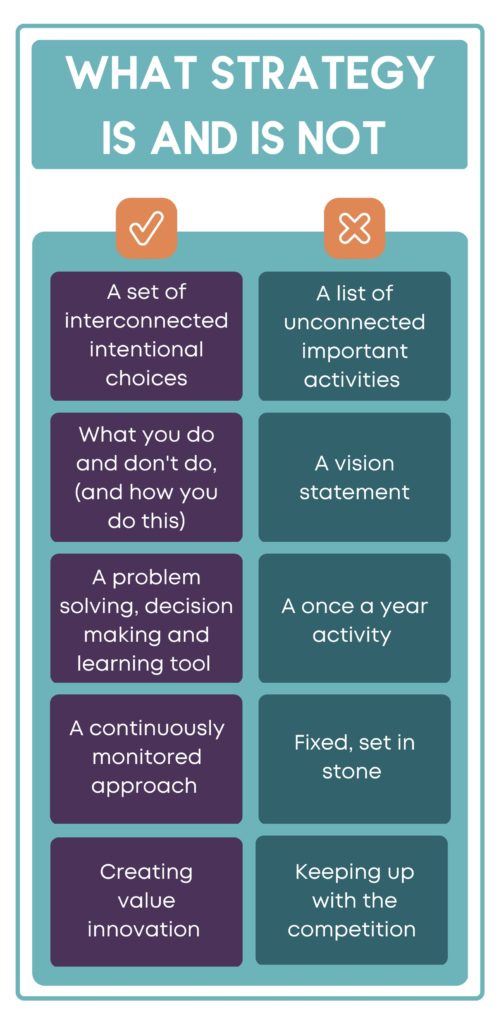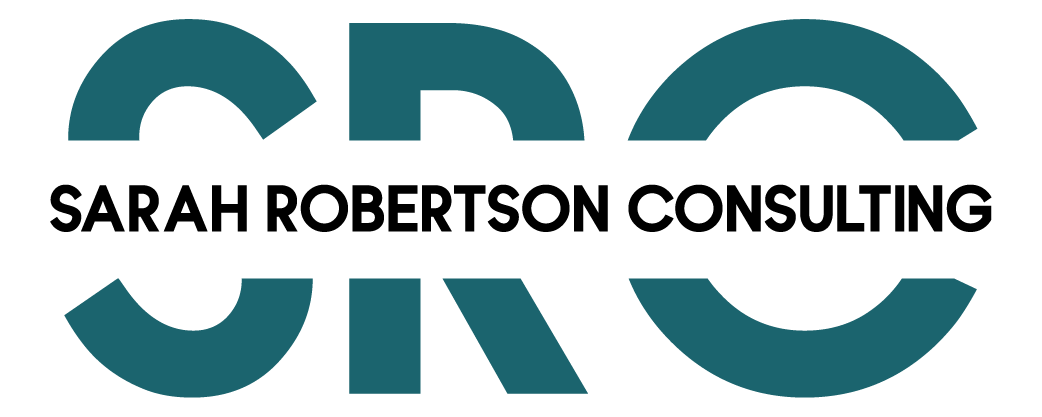As I kick off my strategy blog posts I thought a good place to start is at a high level, what strategy is and is not. Later posts will dig into each of these areas in more detail, but as a summary guide, here are a few key pointers about what strategy is and is not.
A strategy is not a strategic plan.
When I ask clients to share their strategy with me they often show me what I would call a strategic plan. A comprehensive list of big-ticket items they want to action in the next 1-5 years. There is nothing wrong with having a plan, in fact it’s a good thing. But it’s not a strategy. And unless it has been derived from a clear strategy its unlikely to be a plan for success, just a list of big-ticket items that seem important enough to focus on.
A strategy is a series of clearly thought through choices about where and what you are going to do (and not do) and why. Flowing from it will be the activities that you will do, the investments and resources you will need and the things you will stop or reduce – the contents of a high-level plan. But unless you have the higher-level strategy your plan is just a list of activities. Not coordinated, not targeted and not directly linked to your best chance of success.
It’s hard to ratchet up the confidence of the organisation, and the board, to focus time and investment on a plan if you don’t have the strategy behind it.
How do you know they are the very best choice of activities? Unless they flow from a focussed strategy it’s not clear that the choices you make will give you any tangible value-innovation or enable you to achieve your organisational goals.
It’s the articulation of the choices and assumptions in a strategy that make it testable, and therefore less risky, than a plan. This becomes glaringly obvious when the plan is not getting you what you want. Unlike a strategy, a plan does not have clearly articulated assumptions (based on the “what would have to be true” approach of Roger Martin) that you will be continually testing to make sure it’s still correct and viable. In a changing world, you can end up a long way off target by simply following a plan.

Strategy is not a lofty statement
It’s not a vision statement or some ideal about who you are, or aspire to be, in you market. It’s the articulation of what you do, and what you don’t do.
Strategy is not an annual process, it’s not set in stone, and it’s not fixed.
A traditional plan tends to be fixed as it has dates and milestones on it, but for a strategy to be successful you need to be continuously assessing whether the things you think “must be true in order for our strategy to work” really are turning out to be true.
This means you are watching the reactions to your strategy and the outcomes of assumptions you have made. Strategy is never off the executive agenda, it’s never out of sight or out of mind. You might tweak it, you might feel more confident about it and therefore ready to sign-off on big investments, you might find it is heading in the wrong direction and needs to be fully reviewed.
When, and by what degree, you need to adjust your strategy will be immediately obvious as you continuously monitor it. Unfortunately, the changing behaviours of your customers and stakeholders and markets don’t fall neatly into your annual review period. So don’t make this an annual process. It’s as frequent, or infrequent, as it needs to be.
It’s your organisation’s decision-making tool, learning tool and problem-solving tool.
Your strategy solves your biggest problem. In fact, that’s where all great strategies start: what’s the problem we need to solve?
And from that your strategy influences all your decisions, at all levels of the organisation. As you monitor what is working, and not working, from your strategy it becomes one of your best organisational learning tools.
Strategy creates value innovation.
And finally, strategy is never about just doing what the competition are doing. There may be some table stakes that you need to invest in (or not) to keep up (although great strategies will check the assumptions behind this). Fundamentally if you are aiming to keep up with the competition by doing what they are doing then you are engaging in a zero-sum race to the bottom. The goal is to create, what the Blue Ocean Strategy process refers to as Value Innovation: “when companies align innovation with utility, price and cost positions.”
Explore how Sarah Robertson Consulting can support your business or book a discovery call.


